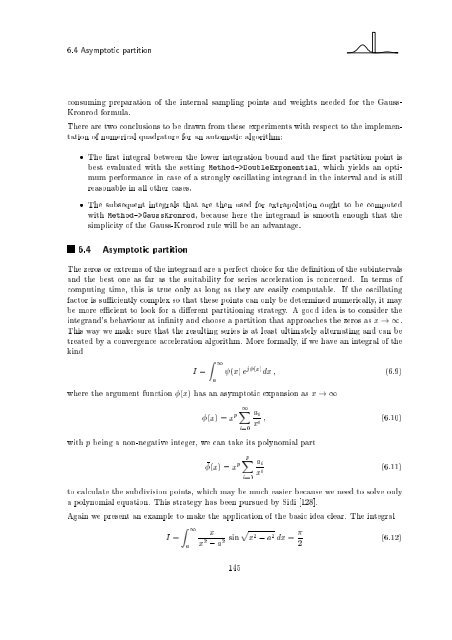Wave Propagation in Linear Media | re-examined
Wave Propagation in Linear Media | re-examined
Wave Propagation in Linear Media | re-examined
You also want an ePaper? Increase the reach of your titles
YUMPU automatically turns print PDFs into web optimized ePapers that Google loves.
6.4 Asymptotic partition<br />
consum<strong>in</strong>g p<strong>re</strong>paration of the <strong>in</strong>ternal sampl<strong>in</strong>g po<strong>in</strong>ts and weights needed for the Gauss-<br />
Kronrod formula.<br />
The<strong>re</strong> a<strong>re</strong> two conclusions to be drawn from these experiments with <strong>re</strong>spect to the implementation<br />
of numerical quadratu<strong>re</strong> for an automatic algorithm:<br />
The rst <strong>in</strong>tegral between the lower <strong>in</strong>tegration bound and the rst partition po<strong>in</strong>t is<br />
best evaluated with the sett<strong>in</strong>g Method->DoubleExponential, which yields an optimum<br />
performance <strong>in</strong> case of a strongly oscillat<strong>in</strong>g <strong>in</strong>tegrand <strong>in</strong> the <strong>in</strong>terval and is still<br />
<strong>re</strong>asonable <strong>in</strong> all other cases.<br />
The subsequent <strong>in</strong>tegrals that a<strong>re</strong> then used for extrapolation ought to be computed<br />
with Method->GaussKronrod, because he<strong>re</strong> the <strong>in</strong>tegrand is smooth enough that the<br />
simplicity of the Gauss-Kronrod rule will be an advantage.<br />
6.4 Asymptotic partition<br />
The zeros or ext<strong>re</strong>ma of the <strong>in</strong>tegrand a<strong>re</strong> a perfect choice for the de nition of the sub<strong>in</strong>tervals<br />
and the best one as far as the suitability for series acceleration is concerned. In terms of<br />
comput<strong>in</strong>g time, this is true only as long as they a<strong>re</strong> easily computable. If the oscillat<strong>in</strong>g<br />
factor is su ciently complex so that these po<strong>in</strong>ts can only be determ<strong>in</strong>ed numerically, itmay<br />
be mo<strong>re</strong> e cient tolook for a di e<strong>re</strong>nt partition<strong>in</strong>g strategy. A good idea is to consider the<br />
<strong>in</strong>tegrand's behaviour at <strong>in</strong> nity and choose a partition that approaches the zeros as x !1.<br />
This way we make su<strong>re</strong> that the <strong>re</strong>sult<strong>in</strong>g series is at least ultimately alternat<strong>in</strong>g and can be<br />
t<strong>re</strong>ated by a convergence acceleration algorithm. Mo<strong>re</strong> formally, ifwehavean<strong>in</strong>tegral of the<br />
k<strong>in</strong>d<br />
I =<br />
Z 1<br />
a<br />
(x) e j (x) dx ; (6.9)<br />
whe<strong>re</strong> the argument function (x) has an asymptotic expansion as x !1<br />
(x)=x p<br />
with p be<strong>in</strong>g a non-negative <strong>in</strong>teger, we can take its polynomial part<br />
(x) =x p<br />
1X<br />
i=0<br />
pX<br />
i=0<br />
ai<br />
; (6.10)<br />
xi ai<br />
x i<br />
(6.11)<br />
to calculate the subdivision po<strong>in</strong>ts, which maybemuch easier because we need to solve only<br />
a polynomial equation. This strategy has been pursued by Sidi [128].<br />
Aga<strong>in</strong> we p<strong>re</strong>sent an example to make the application of the basic idea clear. The <strong>in</strong>tegral<br />
Z 1<br />
x<br />
I =<br />
x2 p<br />
s<strong>in</strong> x2 , a2 dx = (6.12)<br />
, a2 2<br />
a<br />
145












